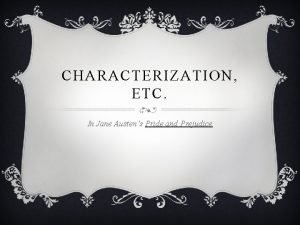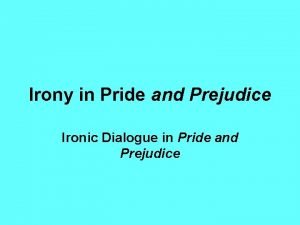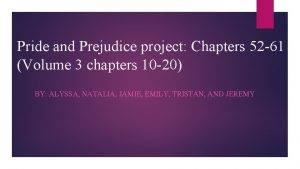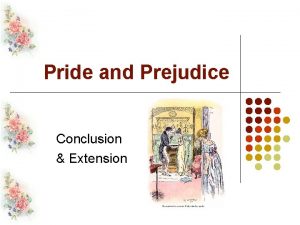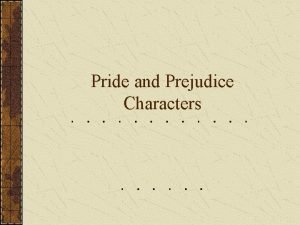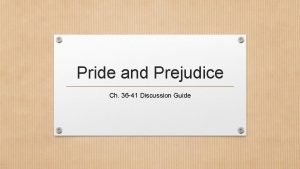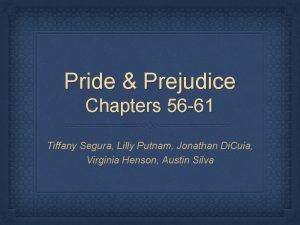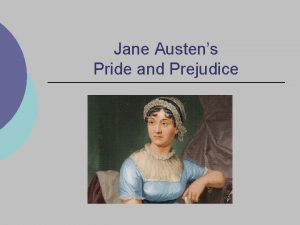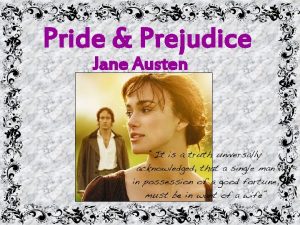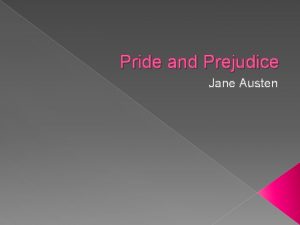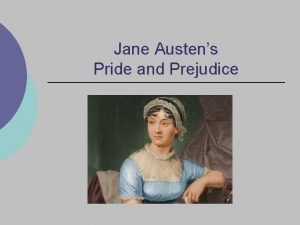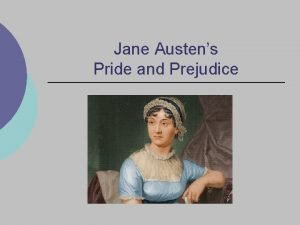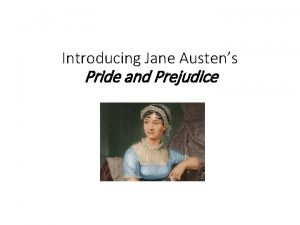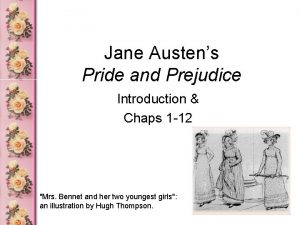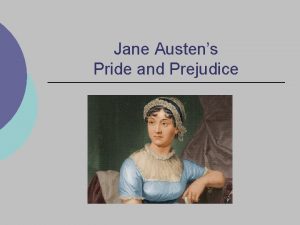CHARACTERIZATION ETC In Jane Austens Pride and Prejudice












- Slides: 12

CHARACTERIZATION, ETC. In Jane Austen’s Pride and Prejudice

DIRECT VS. INDIRECT CHARACTERIZATION Direct Characterization Indirect Characterization v Explicit presentation by v The presentation of the author of the character in action, with little or through direct exposition, no explicit comment by the either in an introductory block or piecemeal throughout the work. author, in the expectation that the reader can deduce the attributes of the actor from the actions.

WHICH IS INDIRECT CHARACTERIZATION? v Mr. Bennet was so odd a v “People who suffer as much mixture of quick parts, sarcastic as I do from nervous complaints humour, reserve, and caprice, can have no great inclination that the experience of three-and for talking. Nobody can tell -twenty years had been what I suffer! But it is always so. insufficient to make his wife Those who do not complain are understand his character. never pitied!" (Spoken by Mrs. Bennet)

ROUND VS. FLAT CHARACTERS Round Characters Flat Characters v Also called three- v Also called two-dimensional characters v Multifaceted, human being v More a type than a human v Capable of inconsistencies being v Subject to growth v Usually not subject to growth v Example: Elizabeth, Aunty Ifeoma, Father Amadi v Example: Jane, Father Benedict

DYNAMIC VS. STATIC CHARACTERS Static Character Dynamic Character v Changes little if at all v Modified by the actions v Things happen to a and experiences character without things v One objective of the work happening within. is to reveal the consequences v Example: Bingley, Papa of these actions v Example: Darcy, Kambili

CARICATURE v. Writing that exaggerates certain individual qualities of a person and produces a ridiculous effect. Unlike satire, caricature is likely to treat merely personal qualities • Example: Mr. Collins’s obsequiousness

FOIL v. Literally a leaf of bright metal placed under a jewel to increase its brilliance v. In literature, the term is applied to any person who through contrast underscores the distinctive characteristics of another. v. Example: Wickham is a FOIL for Darcy; Amaka and Kambili

EPISTOLARY NOVEL v A novel in which the narrative is carried forward by LETTERS written by one or more of the characters. It has the merit of giving the opportunity to present the feelings and reactions without the intrusion of the author; it furthers gives a sense of immediacy because the LETTERS are written in the thick of the action. v Pride and Prejudice is NOT an EPISTOLARY NOVEL, but it does involve several examples of EPISTOLARY WRITING.

SARCASM VS. VERBAL IRONY Sarcasm Verbal Irony v. A caustic and bitter v The actual intent is expression of strong expressed in words that disapproval. v. Personal, jeering, and intended to hurt carry the opposite meaning v Usually less harsh than sarcasm

EXAMPLES Sarcasm Verbal Irony v “You will have a v “There is a mixture of charming mother-in-law, servility and self-importance indeed; and, of course, she in his letter which promises will always be at Pemberley well. I am impatient to see with you. ” (Miss Bingley to him. ” (Mr. Bennet after Darcy upon learning of his reading the letter from Mr. admiration for Elizabeth) Collins)

FOCALIZATION v The perspective through which a narrative is presented. By presenting the narrative through the eyes and words of various characters, the narrator is less removed from the story and the reader is more intimate with the characters (more in their heads). Austen does this in a variety of ways such as epistles and indirect speech, in which the language and thoughts of the characters mix with the voice of the narrator.

EXAMPLE: v “Mrs John Dashwood did not at all approve of what her husband intended to do for his sisters. To take three thousand pounds from the fortune of their dear little boy, would be impoverishing him to the most dreadful degree. She begged him to think again on the subject. How could he answer it to himself to rob his child, and his only child too, of so large a sum? ”
 Indirect characterization in pride and prejudice
Indirect characterization in pride and prejudice Jane eyre pride and prejudice
Jane eyre pride and prejudice Types of irony in pride and prejudice
Types of irony in pride and prejudice Locations in pride and prejudice
Locations in pride and prejudice Pride and prejudice volume 2
Pride and prejudice volume 2 Pride and prejudice chapter 18 summary
Pride and prejudice chapter 18 summary Chapter 52 pride and prejudice summary
Chapter 52 pride and prejudice summary Pride and prejudice conclusion
Pride and prejudice conclusion Pride and prejudice characters
Pride and prejudice characters Chapter 36 pride and prejudice
Chapter 36 pride and prejudice Jane austen historical context
Jane austen historical context Pride and prejudice chapter 59
Pride and prejudice chapter 59 Chapter 56 pride and prejudice
Chapter 56 pride and prejudice
